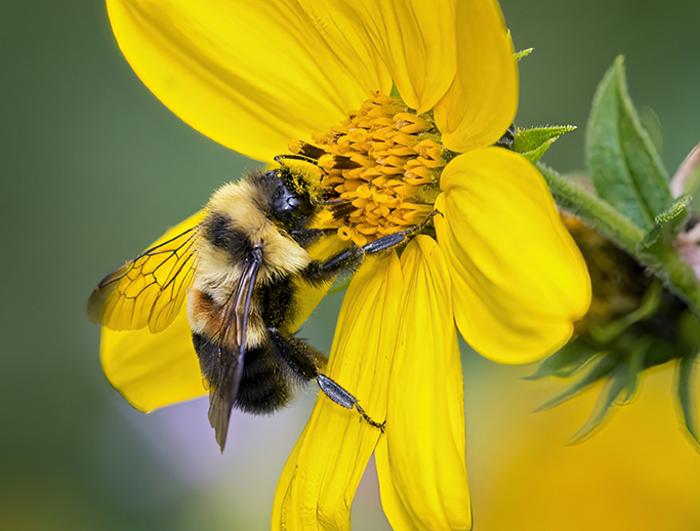LOGAN, Utah, June 20, 2023 — A detailed, high-resolution map of the rusty patched bumble bee’s genome has been released by U.S. Department of Agriculture (USDA) Agricultural Research Service (ARS) and U.S. Fish and Wildlife Service (USFWS) scientists, offering new possible approaches for bringing the native pollinator back from the danger of extinction.

Credit: Photo by Clay Bolt
LOGAN, Utah, June 20, 2023 — A detailed, high-resolution map of the rusty patched bumble bee’s genome has been released by U.S. Department of Agriculture (USDA) Agricultural Research Service (ARS) and U.S. Fish and Wildlife Service (USFWS) scientists, offering new possible approaches for bringing the native pollinator back from the danger of extinction.
Putting together the rusty patched bumble bee genome is part of the Beenome 100 project, a first-of-its-kind effort to create a library of high-quality, highly detailed genome maps of 100 or more diverse bee species found in the United States. Beenome 100 is a collaborative undertaking of ARS and the University of Illinois. The expectation is that this library will help researchers answer the big questions about bees such as what genetic differences make a bee species more vulnerable to climate change or whether a bee species is likely to be more susceptible to a pesticide.
The rusty patched bumble bee (Bombus affinis) is an important pollinator of bergamot (Monarda fistulosa), milkweed, and other wildflowers, as well as crops such as cranberries, plums, apples and alfalfa. But in the last 20 years or so, its population is estimated to have declined by 87 percent.
In 2017, the species was listed as “endangered.” Where rusty patched bumble bees were once common across the Upper Midwest and Northeast in 28 states and 2 Canadian provinces, now their range is down to disconnected spots in 13 states and one Canadian province. Among the few places they are still regularly found is around the Minneapolis-St. Paul area of Minnesota and in Wisconsin.
“With the amount of detailed information that we and other researchers now have access to in this newly sequenced genome, we have an opportunity to find a whole different approach to strengthening rusty patched bumble bee populations,” said research entomologist Jonathan B. Uhaud Koch with the ARS Pollinating Insect-Biology, Management, Systematics Research Unit in Logan, Utah.
Koch explained that some of the factors contributing to the decline of rusty patched bumble bees are already known: loss of habitat, reduced variety of nectar sources, climate change, exposure to pesticides, and more pathogens and pests.
While scientists have known the widespread presence of the fungal pathogen Varimorpha bombi (formerly called Nosema bombi) has a detrimental impact on many rusty patched bumble bee populations, Koch was a bit surprised by how much Varimorpha genetic material he found in the bumble bee sample that was used to develop the genome map.
“We used a small piece of abdominal tissue from a single male collected from a nest in Minnesota, which, given the endangered status of the rusty patched bumble bee, seemed like a very good idea,” Koch said. “It’s only with the most cutting-edge equipment that you could resolve an entire genome of 15,252 genes and 18 chromosomes from a tiny bit of one bumble bee.
It turns out about 4.5 percent of the DNA the researchers sequenced came from Microsporidia, the fungal group that includes Varimorpha bombi. “That’s a massive amount of genetic information from the bee tissue sample to be associated with Varimorpha bombi. It demonstrates how pervasive the pathogen is,” Koch said.
“Having this high-quality genome will support the identification of genetic differences between rusty patched bumble bee populations that appear to be doing well versus where they are in decline,” Koch said. “This may give us a handle on identifying the genes that give the more capable population its flexibility to deal with its environment. We may also gain a better understanding of the genetic basis of bumble bee behavior, physiology and adaptation to changing environmental conditions.”
Once the more successful genes for a particular type of local condition are identified, researchers will be able to give a population a boost in the right direction when it comes to restoring the rusty patched bumble bee to an area through captive breeding programs.
This research was funded by ARS and USFWS. The research was published in the journal G3: Genes | Genomes | Genetics [https://doi.org/10.1093/g3journal/jkad119] and the genome is available on the National Center for Biotechnology Information website https://www.ncbi.nlm.nih.gov/assembly/GCF_024516045.1/ .
The Agricultural Research Service is the U.S. Department of Agriculture’s chief scientific in-house research agency. Daily, ARS focuses on solutions to agricultural problems affecting America. Each dollar invested in U.S. agricultural research results in $20 of economic impact.
#
DOI
10.1093/g3journal/jkad119
Method of Research
Data/statistical analysis
Subject of Research
Animal tissue samples
Article Publication Date
19-Jun-2023




